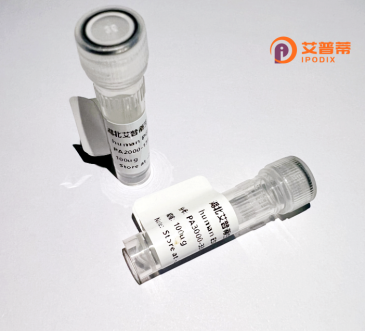
| 纯度 | >80%SDS-PAGE. |
| 种属 | Human |
| 靶点 | SIRT1 |
| Uniprot No | Q96EB6 |
| 内毒素 | < 0.01EU/μg |
| 表达宿主 | E.coli |
| 表达区间 | 193-741aa |
| 氨基酸序列 | MIGTDPRTIL KDLLPETIPP PELDDMTLWQ IVINILSEPP KRKKRKDINT IEDAVKLLQE CKKIIVLTGA GVSVSCGIPD FRSRDGIYAR LAVDFPDLPD PQAMFDIEYF RKDPRPFFKF AKEIYPGQFQ PSLCHKFIAL SDKEGKLLRN YTQNIDTLEQ VAGIQRIIQC HGSFATASCL ICKYKVDCEA VRGDIFNQVV PRCPRCPADE PLAIMKPEIV FFGENLPEQF HRAMKYDKDE VDLLIVIGSS LKVRPVALIP SSIPHEVPQI LINREPLPHL HFDVELLGDC DVIINELCHR LGGEYAKLCC NPVKLSEITE KPPRTQKELA YLSELPPTPL HVSEDSSSPE RTSPPDSSVI VTLLDQAAKS NDDLDVSESK GCMEEKPQEV QTSRNVESIA EQMENPDLKN VGSSTGEKNE RTSVAGTVRK CWPNRVAKEQ ISRRLDGNQY LFLPPNRYIF HGAEVYSDSE DDVLSSSSCG SNSDSGTCQS PSLEEPMEDE SEIEEFYNGL EDEPDVPERA GGAGFGTDGD DQEAINEAIS VKQEVTDMN |
| 预测分子量 | 88 kDa |
| 蛋白标签 | His tag N-Terminus |
| 缓冲液 | PBS, pH7.4, containing 0.01% SKL, 1mM DTT, 5% Trehalose and Proclin300. |
| 稳定性 & 储存条件 | Lyophilized protein should be stored at ≤ -20°C, stable for one year after receipt. Reconstituted protein solution can be stored at 2-8°C for 2-7 days. Aliquots of reconstituted samples are stable at ≤ -20°C for 3 months. |
| 复溶 | Always centrifuge tubes before opening.Do not mix by vortex or pipetting. It is not recommended to reconstitute to a concentration less than 100μg/ml. Dissolve the lyophilized protein in distilled water. Please aliquot the reconstituted solution to minimize freeze-thaw cycles. |
以下是3-4条关于SIRT1重组蛋白的参考文献及其摘要内容的简要列举:
1. **文献名称**:*"SIRT1 deacetylase protects against neurodegeneration in models of Alzheimer’s disease"*
**作者**:Kim D. et al.
**摘要**:研究通过体外重组SIRT1蛋白实验,证明其通过去乙酰化PGC-1α和p53等底物,减少氧化应激和神经元凋亡,在阿尔茨海默病模型中具有神经保护作用。
2. **文献名称**:*"Crystal structure of human SIRT1 in complex with a small molecule activator"*
**作者**:Hubbard B.P. et al.
**摘要**:通过重组表达人源SIRT1蛋白并结合X射线晶体学技术,解析了SIRT1与小分子激活剂(如白藜芦醇类似物)的复合物结构,揭示了其激活机制和底物结合位点。
3. **文献名称**:*"SIRT1 regulates the function of the NIH3T3 cells via deacetylation of FOXO3a"*
**作者**:Motta M.C. et al.
**摘要**:利用重组SIRT1蛋白进行体外去乙酰化实验,证明SIRT1通过去乙酰化转录因子FOXO3a调控细胞周期和应激反应,影响成纤维细胞的增殖与存活。
4. **文献名称**:*"A high-throughput screen for SIRT1 activators using recombinant fluorescent substrate assays"*
**作者**:Milne J.C. et al.
**摘要**:开发了一种基于重组SIRT1蛋白的高通量筛选方法,结合荧光标记的乙酰化底物(如p53肽段),筛选出多种新型SIRT1激活剂,并验证其增强去乙酰化活性的效果。
以上文献聚焦于SIRT1重组蛋白的结构、功能、活性分析及其在疾病模型中的应用。
SIRT1 (silent mating type information regulation 2 homolog 1) is a NAD⁺-dependent class III histone deacetylase belonging to the sirtuin family. It plays a pivotal role in regulating cellular processes such as aging, metabolism, stress response, and genomic stability. Discovered as the mammalian ortholog of yeast Sir2. SIRT1 catalyzes the deacetylation of histone and non-histone substrates, including transcription factors (e.g., p53. FOXO, PGC-1α) and signaling proteins, thereby modulating gene expression, energy homeostasis, and mitochondrial biogenesis. Its activity is closely linked to calorie restriction and lifespan extension in model organisms, making it a key target in aging-related research.
Recombinant SIRT1 protein is engineered through molecular cloning techniques, typically expressed in bacterial (e.g., *E. coli*) or eukaryotic systems (e.g., insect or mammalian cells) to ensure proper post-translational modifications. Purification methods often involve affinity tags (e.g., GST, His-tag) for high yield and specificity. This engineered protein retains enzymatic activity and is widely used *in vitro* to study deacetylation mechanisms, screen activators/inhibitors (e.g., resveratrol, EX527), and explore SIRT1’s role in diseases like diabetes, neurodegeneration, and cancer. Its applications extend to drug development, particularly for therapies targeting metabolic syndromes or age-related disorders. Studies using recombinant SIRT1 have clarified its dual nuclear/cytoplasmic localization and context-dependent roles, underscoring its therapeutic potential and complexity in cellular signaling networks.
×